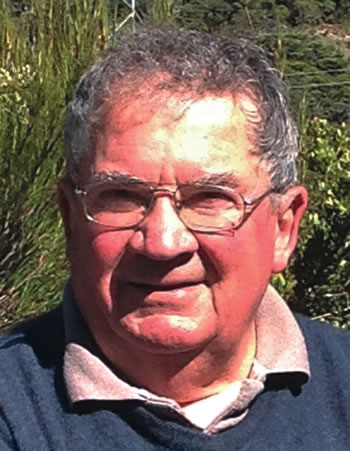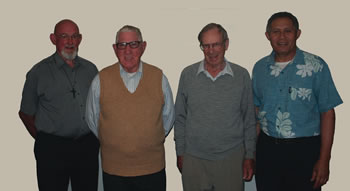Marist Outpost in the Winterless North
Tucked away in the outskirts of Okaihau in Northland is a Marist community house, comprised of three small office buildings cobbled together in 2003/2004. Presently the community is led Fr. Kerry Prenderville, assisted by Fr Sione Matu Lomu and Br. Pius Keene. Fr David Moore (retired) is also in residence.
With roots in Okaihau, I knew there had not been a parish in Okaihau for years, so why are they there? On a tour of Northland, I called in on the community to find out.
Fr Prenderville told me that a Marist community was originally set up in Rawene in 1989 with the aim of taking a new pastoral approach based on training suitable parishoners as catechists. The community had responsibility for Rawene (including Whirinaki, Waiwhatawhata) and Oponone. Moerewa-Bay of Islands, Waitaruke and Kerikeri Parishes were added later.
Because of travelling distances, the decision was made to relocate to Okaihau as it was more central. Fortunately the Parole Board in Kaikohe had moved to new premises and so had three small office buildings available for relocation. These were purchased, shifted to Okaihau in 2003 and joined together to make the new community house.
Subsequently a reduction in staffing at Okaihau resulted in a Diocesan priest being appointed to Kerikeri and Waitaruke, leaving the two Marist priests in the community to care for the other three parishes in the Mid-North Pastoral Area– South Hokianga, Moerewa-Bay of Islands and Kaikohe. With six widely spread Mass centres to cover, the priests work a 3-weekly cycle at each church, with two Sunday Masses followed by a Liturgy of Word and Communion the next Sunday. Fr Sione cares for Rawene, Whirinaki and Waiwhatawhata and Fr Kerry cares for Moerewa, Russell and Pahia.
As well, Fr Kerry is a chaplain to Ngawha Prison and several rest homes and Kawakawa Hospital. He alone drives about 35-40,000 kilometres a year. But Fr Kerry is quick to point out that the community’s primary role is to be a missionary presence through two main tasks: the ongoing formation of catechists (Katekita in Te Reo), and the North Catholic Youth Ministry (NCYM) programme.
Catechists have a rich history amongst the Maori people of Northland. In the early days Bishop Pompallier was quick to establish and train Katekita to collaborate in the teaching of the faith and in the preparation and celebration of the Mass and sacraments. As the Mass was said in Latin and the priest stood with his back to the congregation, the Katekita would stand in the sanctuary and translate the liturgy.
Although that function is no longer necessary because the Mass is said in English or Te Reo, the basic function of teaching the faith and preparation for the sacraments is still a vital one. So there is a compelling need to train men and women who have mana and the capability to lead their whanau groups, not just in the rituals and liturgies of the Catholic faith, but towards a better quality of family life among their own people.
Katekita are recommended and sponsored by their whanau and endorsed by their parish priest. They undergo training in Maori spirituality, Catholic Liturgy, catechesis for children, theology of lay ministry, church theology for Aotearoa-New Zealand, Sunday Lectionary and preparation of reflections, Spirituality of discipleship for Katekita and lay ministers, and rituals for tangihunga, unveilings, blessings of houses, places, objects and people.
Each year all Katekita are expected to attend three hui for ongoing formation and training. To facilitate this, the Diocese of Auckland has agreed to fund the hui and transport costs of the Katekita. Following their successful formation, the Katekita are commissioned for their parish by the Bishop or his representative for an initial period of two years.
Katekita have been commissioned or are in training in six of the nine parishes in Northland (Te Tai Tokerau), but with over 30 candidates on their books there is still a lot of work to be done.
The task of the Katekita is to care for the pastoral and spiritual needs of their people in conjunction with the priests. As such they are distinct from Special Ministers, who are responsible for assisting in the sacramental life of their parish. Although a Katekita may also be appointed as a Special Minister, of course.
The NCYM brings the youth groups of Northland Deanery together twice a year for camps, one this year in North Hokianga, the other in South Hokianga near Dargaville. In common with youth ministries everywhere, the aim is to develop the spirituality of those involved and encourage them in their Catholic faith. They are the future of our Church.
Fr Kerry, in his fourth year at Okaihau, told me they managed such a wide workload because they had the spirituality that suited the task. They recognized long ago that they were involved in a marathon, not a sprint. Their aim is to make themselves redundant, because the Katekita would be capable of taking care of all but the sacramental needs of Te Tai Tokerau.
As I left the house, I thanked God that there was a Marist community in Okaihau, ensuring that our Catholic faith would thrive in my native Northland.



 Entries(RSS)
Entries(RSS)